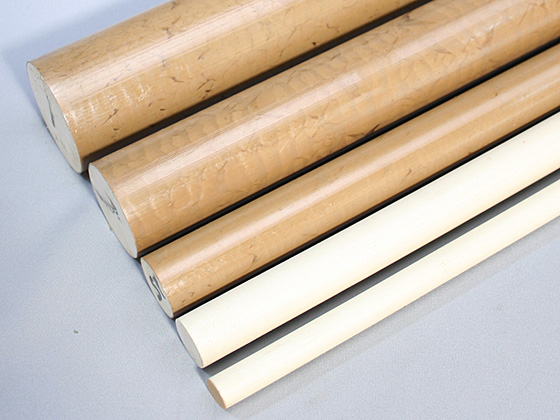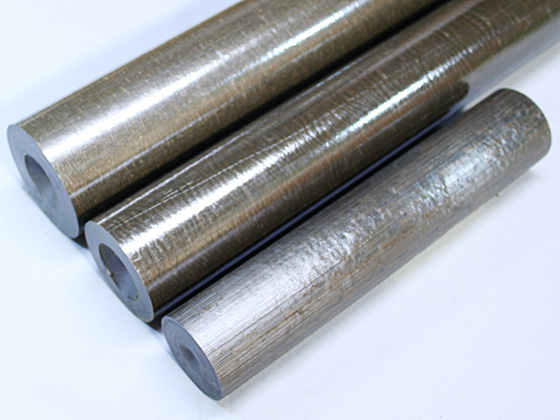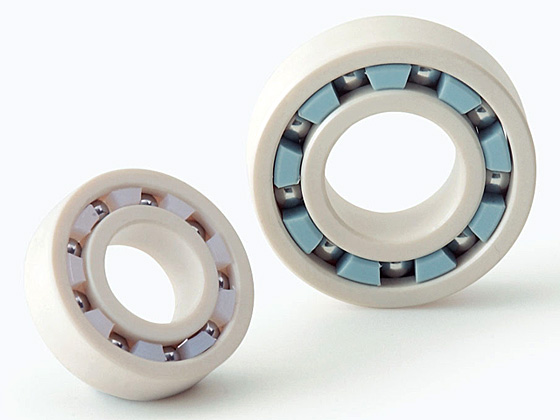 |
 |
 |
These are the properties of PPS (Polyphenylene Sulfide), a material used in plastic bearings. Please review the characteristics of this material.
Overview of PPS
PPS is a crystalline high-performance engineering plastic that features alternating phenyl groups (benzene rings) and sulfur (S) in its molecular structure. It is distinguished by its excellent heat resistance and can be used long-term at high temperatures. It is resistant to chemicals, and oils and solvents that cannot dissolve PPS at temperatures below 200 °C are present. It also exhibits excellent properties in terms of flame resistance, tensile and flexural strength, and it has low shrinkage during molding, resulting in high dimensional stability.
However, PPS has some disadvantages. It has lower toughness (less impact resistance) and lower weather resistance. It is prone to the occurrence of burrs during molding.
Note: Weather resistance refers to the property of plastics or paints to maintain their shape, color, and quality outdoors over the long term without changing, discoloring, or deteriorating.
Characteristics of PPS
◎Recommended ○Satisfactory △Possible to use, but not recommended ×Not compatible
| Material | Product Code |
Dry | Water (extended periods of time) |
Water |
Steam | Chemical Environment | Magnetic Environment |
As Insulator |
|||
|---|---|---|---|---|---|---|---|---|---|---|---|
| Acids | Alkaline | Organic Liquids |
Oil | ||||||||
| Phenol | SD | ◎ | ◎ | ◎ | ◎ | ○ | × | ◎ | ◎ | ◎ | ◎ |
| SDK | ◎ | ◎ | ◎ | ◎ | ○ | × | ◎ | ◎ | × | × | |
| SDHG | ◎ | △ | △ | × | ○ | × | ○ | ◎ | × | × | |
| PTFE | PT | ◎ | ◎ | ◎ | ◎ | ◎ | ◎ | ◎ | ◎ | ◎ | × |
| PTG | ◎ | ◎ | ◎ | ◎ | ◎ | × | ◎ | ◎ | ◎ | ◎ | |
| PTE | ◎ | ◎ | ◎ | ◎ | ◎ | ◎ | ◎ | ◎ | ◎ | ◎ | |
| PTN | ◎ | ◎ | ◎ | ◎ | ◎ | ◎ | ◎ | ◎ | ◎ | ◎ | |
| UHMW | PE | ○ | ○ | ◎ | × | ◎ | ◎ | ◎ | ◎ | ◎ | ◎ |
| PP | PP | △ | ○ | ○ | △ | ○ | ○ | ○ | ○ | ◎ | ◎ |
| PEEK | PK | ○ | ○ | ○ | ○ | ◎ | ◎ | ◎ | ◎ | ◎ | ◎ |
| PKG | ◎ | ○ | ○ | ◎ | ◎ | ◎ | ◎ | ◎ | ◎ | × | |
| PPS | PS | ○ | ◎ | ◎ | ◎ | ◎ | ◎ | ◎ | ◎ | ◎ | ◎ |
| PSG | ◎ | ◎ | ◎ | ◎ | ◎ | ◎ | ◎ | ◎ | ◎ | × | |
| PCTFE | PCT | ○ | ○ | ○ | ◎ | ◎ | ◎ | ○ | ○ | ◎ | ◎ |
| PVDF | PV | ○ | ○ | ○ | ◎ | ◎ | ◎ | ○ | ○ | ◎ | ◎ |
| Carbon | CY | ◎ | ○ | ○ | ◎ | ◎ | ◎ | ◎ | ◎ | ○ | × |
Note: Please contact us for detailed information regarding compatibility with specific chemicals.
Temperature resistance performance of PPS
☆Highly recommended ◎Recommended ○Satisfactory △Possible to use, but not recommended ×Not compatible
| Material | Product Code |
Temperature | |||||||
| -190℃~ | -100℃~ | -50℃~ | -20℃~ | Room or Operating Temperature | ~120℃ | ~200℃ | ~350℃ | ||
| Phenol | SD | × | × | 〇 | ◎ | ☆ | ◎ | × | × |
| SDK | × | × | 〇 | ◎ | ☆ | ◎ | × | × | |
| PTFE | PT | 〇 | ◎ | ◎ | ◎ | ☆ | ◎ | △ | × |
| PTG | 〇 | ◎ | ◎ | ◎ | ☆ | ◎ | △ | × | |
| PTE | 〇 | ◎ | ◎ | ◎ | ☆ | ◎ | △ | × | |
| UHMW | PE | × | △ | 〇 | 〇 | ☆ | × | × | × |
| PP | PP | × | △ | 〇 | 〇 | ☆ | 〇 | × | × |
| PEEK | PK | × | × | 〇 | ◎ | ☆ | ◎ | 〇 | × |
| PKG | × | × | 〇 | ◎ | ☆ | ◎ | ◎ | × | |
| PPS | PS | × | × | × | 〇 | ☆ | ◎ | 〇 | × |
| PSG | × | × | × | 〇 | ☆ | ◎ | 〇 | × | |
| PCTFE | PCT | × | × | 〇 | ◎ | ☆ | 〇 | × | × |
| Carbon | CY | × | × | △ | 〇 | ☆ | ◎ | ◎ | ◎* |
*Note: Please consider the coefficient of thermal expansion, or contact us for specialized applications.

